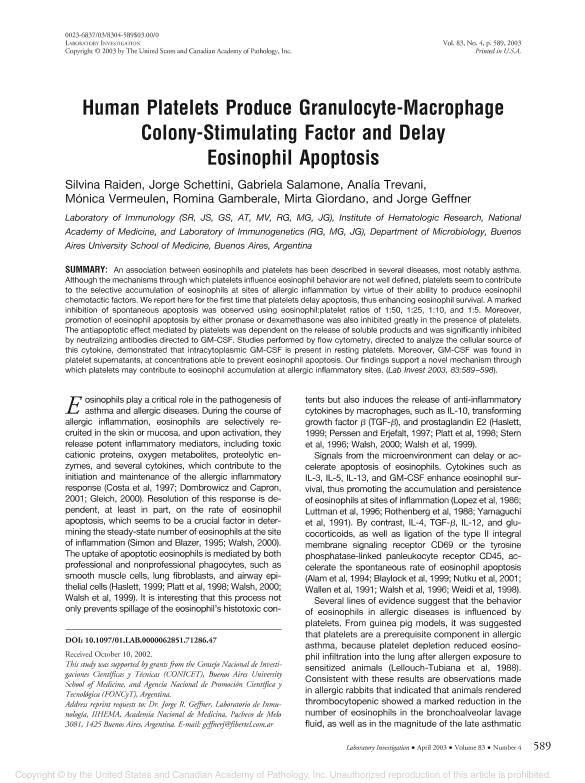Artículo
Human platelets produce granulocyte-macrophage colony-stimulating factor and delay eosinophil apoptosis
Raiden, Silvina Claudia ; Schettini, Jorge; Salamone, Gabriela Veronica
; Schettini, Jorge; Salamone, Gabriela Veronica ; Trevani, Analía Silvina
; Trevani, Analía Silvina ; Vermeulen, Elba Monica
; Vermeulen, Elba Monica ; Gamberale, Romina
; Gamberale, Romina ; Giordano, Mirta Nilda
; Giordano, Mirta Nilda ; Geffner, Jorge Raúl
; Geffner, Jorge Raúl
 ; Schettini, Jorge; Salamone, Gabriela Veronica
; Schettini, Jorge; Salamone, Gabriela Veronica ; Trevani, Analía Silvina
; Trevani, Analía Silvina ; Vermeulen, Elba Monica
; Vermeulen, Elba Monica ; Gamberale, Romina
; Gamberale, Romina ; Giordano, Mirta Nilda
; Giordano, Mirta Nilda ; Geffner, Jorge Raúl
; Geffner, Jorge Raúl
Fecha de publicación:
04/2003
Editorial:
Nature Publishing Group
Revista:
Laboratory Investigation
ISSN:
0023-6837
Idioma:
Inglés
Tipo de recurso:
Artículo publicado
Clasificación temática:
Resumen
An association between eosinophils and platelets has been described in several diseases, most notably asthma. Although the mechanisms through which platelets influence eosinophil behavior are not well defined, platelets seem to contribute to the selective accumulation of eosinophils at sites of allergic inflammation by virtue of their ability to produce eosinophil chemotactic factors. We report here for the first time that platelets delay apoptosis, thus enhancing eosinophil survival. A marked inhibition of spontaneous apoptosis was observed using eosinophil:platelet ratios of 1:50, 1:25, 1:10, and 1:5. Moreover, promotion of eosinophil apoptosis by either pronase or dexamethasone was also inhibited greatly in the presence of platelets. The antiapoptotic effect mediated by platelets was dependent on the release of soluble products and was significantly inhibited by neutralizing antibodies directed to GM-CSF. Studies performed by flow cytometry, directed to analyze the cellular source of this cytokine, demonstrated that intracytoplasmic GM-CSF is present in resting platelets. Moreover, GM-CSF was found in platelet supernatants, at concentrations able to prevent eosinophil apoptosis. Our findings support a novel mechanism through which platelets may contribute to eosinophil accumulation at allergic inflammatory sites.
Archivos asociados
Licencia
Identificadores
Colecciones
Articulos(IMEX)
Articulos de INST.DE MEDICINA EXPERIMENTAL
Articulos de INST.DE MEDICINA EXPERIMENTAL
Citación
Raiden, Silvina Claudia; Schettini, Jorge; Salamone, Gabriela Veronica; Trevani, Analía Silvina; Vermeulen, Elba Monica; et al.; Human platelets produce granulocyte-macrophage colony-stimulating factor and delay eosinophil apoptosis; Nature Publishing Group; Laboratory Investigation; 83; 4; 4-2003; 589-598
Compartir
Altmétricas



